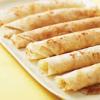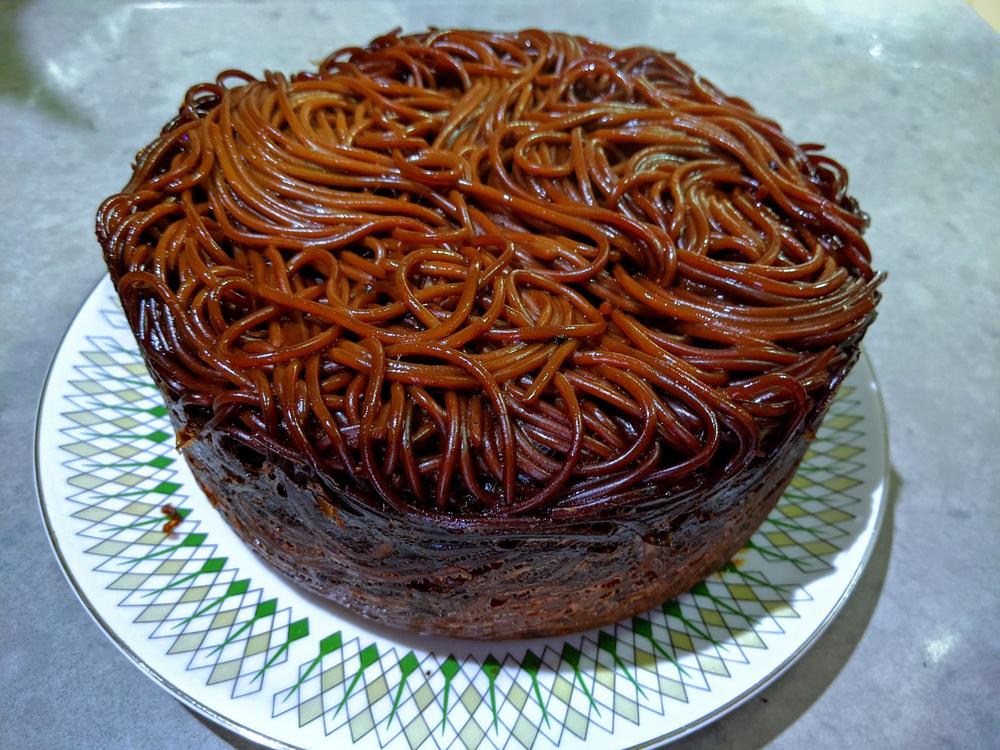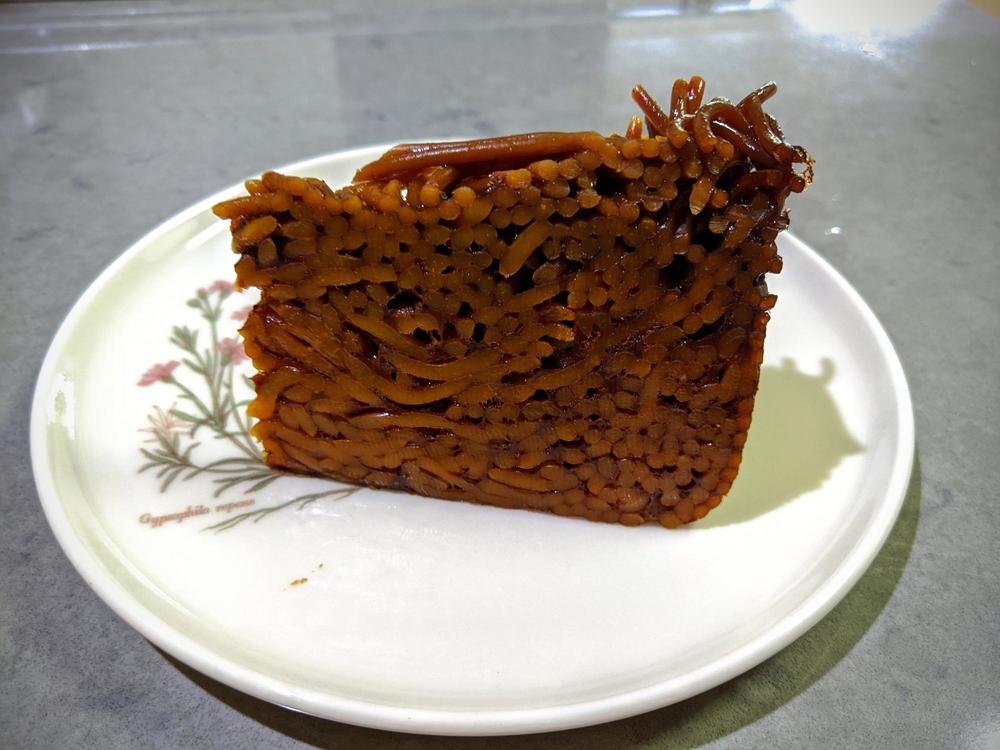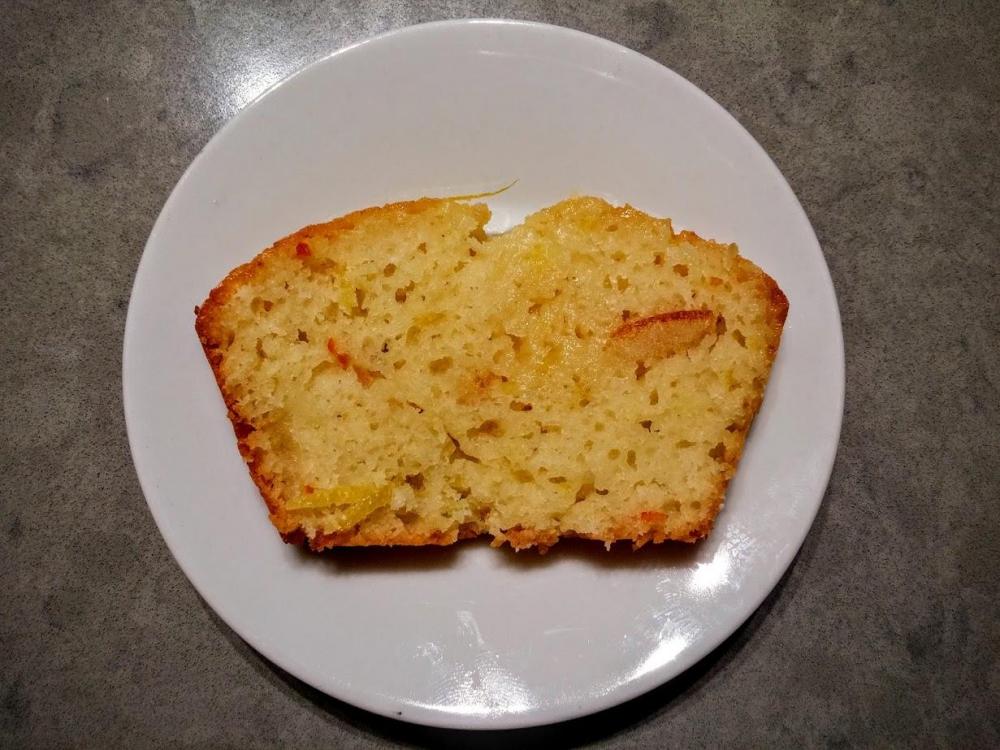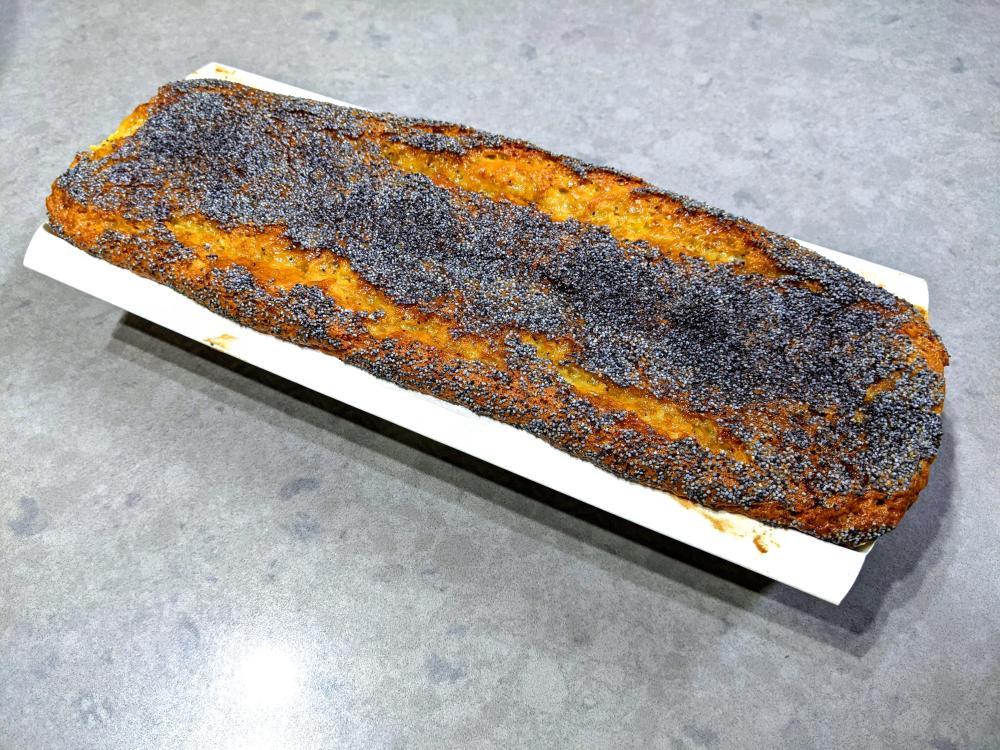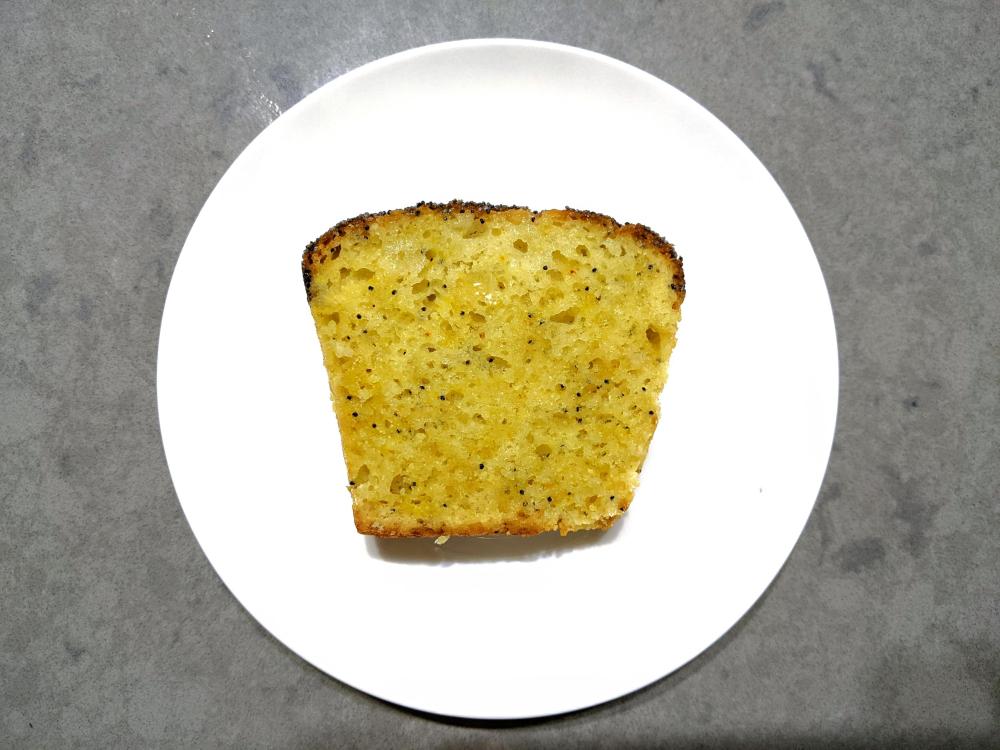Search the Community
Showing results for tags 'Recipe'.
-
Ingredients (for 4 people): 3 long sticks of rhubarb 250g of strawberries 4 tablespoons of xylitol 4 tablespoons of butter 150g of desiccated coconut Heat the oven up to 180C. Wash the rhubarb, peel it and cut it into 1 cm pieces. Sprinkle with 2 tablespoons of xylitol, mix it in and leave for half an hour. Wash the strawberries, remove the shanks and cut them into small pieces. Drain the rhubarb from the juice and mix it in with the strawberries. Melt the butter. Mix the desiccated coconut with the rest of the xylitol and butter. Smooth some small casserole dishes with a bit of butter. Put the rhubarb and strawberries into them. Sprinkle with the desiccated coconut crumble topping. Bake for 15-17 minutes. Serve with strawberry or vanilla ice cream.
-
Today we had fresh fillets of red snapper on our table. Raw red snapper is light red, but after baking the meat is white and mild. I served it with green asparagus spears and an interesting tasting salsa with low-salt cucumbers. A big asset of this dish is its flavour, spectacular looks and that it only took 30 minutes to prepare. I like this kind of dish! Ingredients (for 4 people) 800g of red snapper fillets 6 sprigs of thyme 3 sprigs of rosemary 4 cloves of garlic (unpeeled) salt, white pepper salsa 4 low-salt cucumbers half a red pepper half a chili pepper 2 cloves of garlic (peeled) 4 tablespoons of minced chives 2 teaspoons of honey the juice from half a lemon other ingredients: 2 bunches of asparagus spears Firstly, prepare the salsa. Dice the low-salt cucumber and red pepper. Chop the garlic and chili pepper. Mix in the cucumbers, two kinds of pepper, garlic and chives. Spice it up with the lemon juice and honey. Leave in the fridge for 20 minutes. Heat the oven up to 180C. Cover a casserole dish with some baking paper. Sprinkle it with some olive oil. Cut the fillets of fish into pieces (whatever size suits you) and spice them up with salt and white pepper. Put them and the rosemary, garlic and thyme on the baking paper. Bake for 20 minutes. Wash the asparagus spears, remove the lignified parts and boil them al dente for 8-10 minutes in lightly salted water. Arrange the asparagus spears, two tablespoons of salsa and the pieces of fish on a plate. Decorate with a bit of salsa and the thyme sprigs.
-
Strawberry dessert with chia seeds Ingredients (for 4 people) 300g of strawberries 300ml of milk (it may be coconut milk or whatever you prefer) honey or maple syrup 4 tablespoons of chia seeds fruit and peppermint leaves for decoration Clean the strawberries and remove the shanks. Add the milk and one tablespoon of honey or maple syrup. Blend it thoroughly. Try it and if necessary add a bit more honey. Add the chia seeds, mix them in and leave in the fridge for 4-5 hours. Stir once again. Put the dessert into a small bowl and decorate with the fruit and peppermint leaves. The inspiration for this dessert comes from "Smaki życia" ("Flavour of Life") by Agnieszka Maciąg
-
Consider making this if you have some late tomatoes that need to be used, or live in a part of the world where it's summer. If you don't have ripe fresh tomatoes, canned ones work very well. In Israel, shakshuka is most popular as branch or breakfast, but it can also make a lovely dinner. This serves four. The sauce can be made ahead, portioned and kept refrigerated for a few days, or frozen. Base souce: a little oil (1/2 tablespoon) 700-750g ripe red bell peppers (3 large), cut to roughly 1cm (1/2") 650g of very ripe tomatoes (5 large), optionally peeled and roughly chopped (about 3cm, 1") 1-2 hot green chilies of your variety of choice (preferably vegetal and not bitter), thinly sliced into rings 3.5 teaspoons salt (to taste) about 1/2 teaspoon black pepper A few tablespoons of chopped parsley A couple of tablespoons of chopped cilantro (optional) Spice paste: about 2 tablespoons of good olive oil 8-9 cloves of garlic, minced 3 teaspoons of ground cumin (freshly ground if possible) 1/2 teaspoon of ground or whole caraway (optional) 2-2.5 tablespoons of Moroccan sweet paprika (more earthy and less sweet/herbal then hungarian. I think spanish style will be good as well) If you like extra hot, or if you don't use fresh chili, then sub hot paprika for some of the sweet paprika Tahini sauce (makes more then needed): 1/2 cup good tahini (seek one which is pale, nutty and naturally sweet) 1/2 cup very cold water 3 tablespoons lemon juice (+ more to taste) salt to taste 1-2 cloves of minced garlic (optional) -- Mix all of those, add more water if it is very thick. Can be kept up to 4 days. To finish: about 8 eggs (assuming 2 per serving) more salt and pepper, to season the eggs some more parsley about 2 tablespoons of the tahini sauce To serve along: A crusty bread with a soft crumb, unsliced (I usually opt for challah or french style bread) - make sure to slightly heat it in the oven so that it gets crisp and warm More of the tahini sauce Extra hot sauce - Filfel chuma is the best if you can buy, or make it (very easy to do so) Olives (or pickles) Process: Prepare the spice paste: in a small pan, heat oil, garlic, cumin, caraway - until aromatic and lightly sizzling, about 3 minutes. Add paprika and stir. Cook a minute or so and remove from heat. Prepare the sauce: In a shallow wide pot, or a deep pan, saute the bell peppers with a little oil over medium-high heat. Add a generous tablespoon of the spice paste and stir with the peppers. Cook until the peppers soften, roughly 10 minutes, being careful not to burn the spices. Add the tomatoes. Lower the heat to medium-low, and cook for another 30 minutes or so, until thickened slightly (it will get thicker with the eggs). Add remaining spice paste. Add salt, pepper and herbs. At this point, the sauce can be portioned and refrigerated. If portioned, transfer the sauce to a pan of suitable (smaler) size. Lower the heat. If cooking 4 eggs or more, break them ahead of time onto a plate. Using a spoon, create a shallow indentation in the sauce for each egg (this will keep them from sliding). Place an egg in each indentation. Gently stir the egg whites with the sauce around them, only a little - do not break the yolks. Season the top of the eggs with some salt and pepper. Cover with a lid and cook on a bare simmer, until the eggs are just barely cooked (like poached eggs) - consider that they will cook some further from the residual heat of the sauce. Sprinkle with parsley, drizzle with tahini. Shakshuka is served in the pan it was cooked in! If you eat alone (or comfortable with your companion), eat directly from the pan. Otherwise, gently transfer to a plate. The bread is best left unsliced, rather teared and dipped into the sauce and eggs (The Hebrew language has a term for tearing of bread - לבצוע Livtzo'a). Add more tahini and hot sauce as pleases you.
-
How to Make Rye Sourdough Bread I don't know what it is about bread, but it is my favorite thing to make and eat. A freshly baked loaf of bread solves a world of problems. I was lucky enough to get to be one of the main bakers when I worked at the Herbfarm. We baked Epi, Baguettes, Rolls, Pretzels and so much more. Rye Sourdough Wood Oven Baked Bread My fondest memory when I worked there was our field trip to the Bread Lab(wait something this cool came out of WSU, of course!) here in Washington. They grow thousands of varieties of wheat and have some pretty cool equipment to test gluten levels, protein, genetics and so on. I nerded out so hard. What came out of that trip was this bread. Now I can't recall the exact flour we got from them, but using a basic bread and rye will do the trick. We used to get a special flour for our 100 mile menu. This was where we were limited to only serving food from 100 miles away. So finding a wheat farm that made actual hulled wheat in 100 miles was a miracle. The year before...the thing we made, was closer to hard tack. Now if you don't have a starter, I recommend starting one! It is a great investment! Rye Sourdough 1000 g flour (60% Bread Flour, 40% Rye) 25 g salt 75 g of honey/molasses 200 g of Rye starter 650 g of water, cold Equipment Baker Scale (or other gram scale) Bench Cutter Bread Razor (you could also use one of those straight razors) Start by taking the cold water, yeast and Honey and mix together and let sit for 10-15 minutes I know, some of you just freaked out, cold water? Won't that kill the yeast. Nope, the yeast just needs to re hydrate. I prefer using cold water to slow the yeast down. That way the lactobacillus in the starter has a good amount of time to start making lactic acid, and really get to flavor town! While that is sitting, I mix the flour and the salt together(How many times I have forgotten to salt the bread). Now mix the two products with a kneading hook for 3-5 minutes, only until thoroughly mixed but not yet at the window pane stage of kneading. Instead, place into a bowl and set a timer for one hour. Then when that hour is up, push the dough down and fold all the corners in Repeat this step 2-3 more times, pending on the outside temperature. If you happen to have those cool bowls to shape round loafs! Awesome, use them. I would break the boules into 3 balls of about 333 grams If not then just put the dough in the fridge and do the steps below the next day. Once you have bouled the bread, can put it into the fridge and let it sit over night Again, this lets the bacteria, really get to work(misconception is the yeast adds the sour flavor, nope, think yogurt!) Now on the next day, heat up whatever form of oven you plan to use. We used a brick oven but if you just have a normal oven, that is fine. Crank it to 450 degrees Fahrenheit. If you have not bouled your bread yet, go back and watch the video and break the dough down into three balls of abut 333 grams. Then place the balls on a lightly greased sheet pan. Let sit for about 45 minutes to 1 hour. If you have used the fancy bowls then turn the the bread out on a lightly greased sheet pan, without the bowl and let temper for 15-30 minutes. If your oven is steam injected, build up a good blast of steam. If not, throw in a few ice cubes and close the door or put a bath of hot water inside. The steam is what creates the sexy crust! Let it build up for a few minutes! Right before you put the bread into the oven use a bread razor to slice the top of the bread. Place the dough balls into the oven and douse with another blast of steam or ice and close the oven. Let them bake for 13 minutes at 450 degrees. Then turn the loaves and bake for another 10 minutes. Remove when the crust is as dark as you want and the internal temperature exceeds 190 degrees Fahrenheit. Now pull out and make sure to let cool off of the sheet pan with room to breath underneath. You don't want your crust steaming! Now here is the hardest part, wait at least 20 minutes before getting into the bread. Also, cutting into bread to early really seems to come out poorly. I would rip the bread until 1-2 hours has passed. Now serve it with your favorite butter, goat butter or whipped duck fat!
-
Where do Chefs get most of their ideas from(besides Sunday night projects!)? Honestly, a combination of books and leftover products. Duck fat is either in over supply or high demand in most kitchens. It depends on how many ducks you have broken down, how much time you spend rendering fat and if you are currently doing duck fat potatoes on your menu. When I worked at the Herbfarm, we would often have large vats of duck fat and pork fat. This brought about the question. What do we do with all this duck fat/pork fat? Well, you can confit everything in duck and pork fat. It tastes great. However, we were the Herbfarm. We had to try to add a twist. Now this dish may have come from Heston Blumenthal originally, I can't recall. To me, in a kitchen, what's new is old and what is old is new. Or as King Solomon said "There is nothing new under the sun" (ironically, I am sure he stole that from someone). So this dish is simple and really requires very little prep, minus the cracklins. What you will need: 8 oz of Duck/Pork Fat 2 Bunchs of Chives, slice extra thin(make sure you have a sharp knife!) Salt to taste Any leftover duck skin from rendering If you don't have that 1-2 oz of crisped and crumbed bacon will work Equipment: Cube shaped molds Butchers Twine Piping bag Whipped Version - BETTER Tasting: Now there are two ways to approach this "dish", not really a dish, product. I prefer the whipped version. It just tastes so airy. It is like whipped cream vs. cream. Let you duck or pork fat soften at room temperature. You don't want to break your kitchen aid. Once it has tempered, place all 8 oz in a mixer and beat on high for a few minutes with a few good pinches of salt. You should see the color start to brighten up. After that, let it beat for another 2-3 minutes. Then when it looks very airy, use a spatula to fold in the chives and crispy skin or back. Now make sure you have the butchers twine cut into several inch pieces. It is ok if they are too long, you can cut them later. Place the whipped fat in a piping bag. Now here is the only reason I don't like the whipped method. It produces a better product by far! However, it can be a little messier. I usually put the twine in and pull one end to a corner. Pipe the fat into the cube mold till it fills it slightly above the top. Pull the string towards the middle, and flatten the top using an offset spatula. Once all your molds are filled and wicked, place into the fridge until you need it. Then pop it out! Melted Version: Alright, this is not my preference, but it is way faster and easier but the chives and cracklins tend to settle at the bottom. Lightly warm your duck or pork fat. No need to bring it to anything above 150 degrees. Let it cool if it gets too hot Then while it is still fluid, mix in the chives and cracklins. Now using the cube molds and the wicks, put the wick in first. It will be easier, trust me! Same idea, pull the wick to the side and then pour in the fat. Obviously, way easier and cleaner than piping, but again, think whipped cream vs cream. Now once they are all wicked, place in fridge till firm. Serve with a nice slice of Rye Sour dough bread! Or maybe another bread from Tartine's Bread Book!
-
**The top portion is a little more story, but if you don't want to read that, skip on down to the recipe!** Black Sesame Seed Gelato Black Sesame, Douglas fir Granita and toasted chocolate One of the recipes I loved from Cafe Juanita was the Gelato recipe. One, it was easy to memorize and two every time I have used it and in every kitchen I have been asked for the recipe. Oh, and I forgot the best part. So this recipe is called "Black Sesame" but really I will give you the base and from there you can make any flavor you want! I have made Smoked Caramel, Douglas fir, Cardamon, Pistachio, Olive oil and 31 other flavors (actually more!). So you can make a huge batch of this and take it from there! The key to the recipe is understand how Gelato and Ice Cream works. Frozen custards relay on various variables to reduce the amount of ice crystal that from in the custard. Higher fat, higher hydrocolliods, faster sheering of a blade, etc. Each of these decrease the ability for ice crystals to form. So when considering making a flavor fat, protein, sugar and churning levels all have to be taken into account. These all play a role. Not only that, sugar, fat, and protein play a huge role in not only texture, but stability at room temperature. For instance, have you ever had chewy ice cream and I am not referring to Turkish Ice cream. I am referring to overly stabilized ice creams. Whether this is with carrageenan or guar gum. All stabilizers are double edged swords. If you have 500 hundred quenelles that you have to do. Stabilizers are a life saver. Yet, your texture suffers. **Warning***If you want to to go straight to the recipe, skip the next three sections! Fat Let me tell you a horror story about high fat gelato. One such night, the first night I went from being an Intern to a paid employee at Cafe Juanita we had to serve a 30 top down stairs. I was in charge of the dessert. A nectarine tart with Olive oil gelato. One key with high fat ice creams and gelatos is proper tempering. If you haven't tempered an ice cream with high fat, and have to scoop 30 quenelles. You are screwed. I still remember that night. Holly came down, and she didn't yell, she didn't scream. Her words still cut like a hot dagger through my young self-esteem. I told you I just started getting paid, after 3 months of interning. Her first question was "Why am I even paying you". Instant shut down, me a 17-year old kid who had plenty of imposter syndrome to deal with, was broken. I couldn't even respond.#cheflife..but that doesn't have too much to do with Gelato. It is more just to make the point that high fat means a harder freeze. Also, sometimes it makes it more like frozen butter. This is not a pleasant texture and you should think about the final fat content. If I am making a pure nut gelato, I often just use a nut butter and simple syrup. There is no need for cream, whole milk or egg. You actually want to reduce fat. Sugar Now where high fat makes ice creams more stable. Increasing sugar does quite the opposite. The sugar molecule decreases the temperature required for a hard freeze. I learned to hate the Burnt sugar gelato at Cafe Juanita. If it was even close to 80 degrees outside, the little freezer we had upstairs couldn't handle being open and closed all service. I would be able to server maybe 3 servings before I just had to say we were out. If you happen to make this recipe and have any questions about flavor adjustments, feel free to send me an email! Hydrocolliods If you don't like nerd talk, you should skip to the recipe now! If you like knowing random facts about things to "impress" people at parties. Then keep reading. The word has two parts. The hydro referring to water and the collid referring one product that is microscopically dispersed insoluble products in another substance. What this translates to, is small particles floating around in water. In particular, these products often create a matrix that suspends fluid. This would be xanthan gum, guar gum, carrageenan, egg yolks, and many others. If you have ever looked at the ingredients in store bought ice cream, some of these may be familiar. These help maintain the structure of the ice cream. Some of them can even withstand a decent amount of sitting at room temperature. Too much does make your ice cream rather chewy... But enough of that, let's get to the recipe! Recipe 1 Gallon of Whole Milk 900 g egg yolk 1000 g sugar 500 g black Sesame(toasted) 1 tbsp of salt Equipment needed Vitamix or other blender! Ice Cream Machine 2 Gallon Pot- or double the size of your final proportion 2 Gallon Bowl Whisk Alright, this recipe is pretty simple. Have you ever made custard or creme anglaise? Well, that is all you are going to do here. Start by taking the whole milk and heating it on the on a medium high heat. Make sure you watch it so it doesn't over boil (trust me, I have had to clean plenty of stove tops because of my one track mind). In a bowl that can hold two gallons! mix the egg yolks, sugar and salt, and beat until thick. Once your milk has come up to a boil, take it off the heat. Make sure you have a ladle and a whisk ready and clean(more important for cooks...). Then slowly ladle in the hot milk and whisk. This is called tempering, it protects the egg yolks from scrambling. You want to make sure you bring the egg yolks up slowly and whisk constantly. Otherwise you will end up with egg chunks! Once mixed, you will more than likely have to put this mixture on the stove top again at low heat(10% of the time it might cook to the right temperature and you won't have to do this step). Bring the mixture up to 160-165 degrees. This should be at what is called the "Nape" stage. This refers to being able to stick a spoon in the custard base, pull it out a scrape a line down the center. As in the picture below. ****Warning***** be mindful of the bottom of your pan. You have to keep mixing constantly, maybe even with a heat proof spatula. Otherwise, you will get scrambled eggs at the bottom. A little is ok, and can and should be strained out! Set up a bowl that will fit your final custard over a bowl with ice water. This will just help cool down your product faster, and if by chance you were getting too hot, save you from having scrambled eggs. Once your custard has reached the proper stage of Nape. Strain your product through a fine sieve or other strainer into your two bowl combination. That was your base. From there, you can take your base and make any flavor you want! Again, let me know if you have any questions! Black Sesame Starting with the base, take half your toasted black sesame and enough liquid to fill 1/2 of your blender. Don't over fill your blender...that is my job...I have seen blenders explode more than once... Place the sesame seeds and base you have from the previous step into your Vita-mix. Blend for a few minutes, its ok if it is not super smooth. We will be straining later on. Repeat this step until all your sesame seed is pureed and mix both of the batches with the rest of your custard. Allow this to sit over night. The next day, strain the product through a fine sieve. Season to taste with more salt if necessary. Honestly, salt in this makes it! From here, it depends on what kind of ice cream maker you have. When I did this dish, we actually used dry ice to make the ice cream. If you are curious on the steps, feel free to ask! No ice cream maker required!
-
For 3 medium pizzas (4 large-ish slices each) or 2 large pizzas (I recommend that you stick to medium sized ones). 425g (15oz) high gluten (bread) flour 272g (9.6oz) room temp water (based on hydration percentage: 272=425*0.64) 10.5g ( 0.4oz) salt 16g (4 tsp, 0.53oz) sugar 17g (1.5 tbsp, 0.6oz) olive oil 6.5g (2 tsp, 0.25oz) instant yeast (or 2.5g dry) If you have non-diastatic malt powder, adding a little will add a nice flavor Note: edited 2020, since my recipe changed since 2016. The original version called for 6.5g salt, 21g olive oil, 12g sugar. If using dry yeast, dissolve it in the water, instant yeast can be mixed with the flour. Mix all dry ingredients, pour in the water. Using a mixer, knead 5 min, let rest 10 min, knead 5 min more, or until well developed. If you use your hands, it's better to knead more times, for shorter periods and shorter rests in between. Put the dough in the fridge at least overnight, preferably 2-3 days and up to 6 days. Once the dough is risen, Take it cold from the fridge and place it on a dusted surface. Divide into as many pieces as you want pizzas. Shape into tight balls. Use semolina or flour as needed, try not to overuse it, but it's better than having it stick. Place the balls on a generous dusting of semolina or flour so it won't stick to the surface. Keep it covered. I use an upside down bowl, but a dusted towel will work. Let it rise for 1 to 2.5 hours (1 in summer, 2.5 in winter). Don't forget to preheat your oven at least 40 minutes before it's time to bake (even more time if you use a stone instead of steel). You want as high as your oven will go (mine gets to ~270C). When the dough is risen, puffed and slack - Place a parchment over a peel or upside down oven sheet. I like to cut the corners of the parchment so to not risk it burning. Shaping takes a little practice and is up to personal preference. There are good videos online. Take a ball and dust lightly. Flatten it gently, don't remove much air. Do pinch any large bubbles. Put the dough on your closed fist and gently shake to extend the dough edges downwards. Hold the dough with two hands, using your finger to grab it slightly inside from the rim, as to keep the air in it. Let gravity stretch the dough downwards, as you rotate it in the, much like a steering wheel, gently stretch the dough sideways between your hands as you do so (I hope this description made sense). When the dough inside the rim is thin and almost, but not yet allowing light through, place the dough on the parchment. Lift the edges and stretch it to its full size and restore its circular shape. Top as desired. Use cold ingredients, especially the cheese, which is also better cubed than grated. I'll use apx. 90g (3.2oz) of mozzarella per medium sized pizza. Set the oven to top broiler/grill on maximum power for one minute, then slide the pizza and the parchment together into the oven and . Bake until getting slightly charred, but avoid browning the cheese. Let the oven reheat a little (back in regular, non grill setting) before baking the next pie, and turn the broiler back on a minute before inserting it. A note about baking - you want the baking steel to preheat as much as you can before inserting the pizza. You want to make sure the broiler is on for a minute before inserting the pizza, but not too long ahead so that it won't be stopped by the thermostat. Please tell me if there is something you'd like me to clarify. My favorite toppings: All are for medium sized pizzas, scale by 1.5 for a large pizza. The amounts are in grams, but that doesn't mean it needs to be precise at all. All toppings should be fridge-cold, especially the cheeses. Classic NY style: 5 large ripe, sauce tomatoes (like roma or san-marzano) either fresh or canned - peeled , chopped, salted , drained and crushed (500g / 17oz) 100g cold semi-dry mozzarella (3.5oz), chopped Fry some garlic in olive oil. Add the tomatoes and cook until slightly thickened but still bright tasting. Add salt to taste and some basil, chili, etc. Spread the sauce and sprinkle the cheese. Pesto-ricotta: 90-100g ricotta (3.5oz), mixed with some salt and pepper 50g cold mozzarella (1.8oz) 100g pesto, semi frozen or at least fridge-cold (3.6oz) 5-6 cherry tomatoes, halved Spread the mozzarella evenly, drop chunks of pesto and ricotta. Scatter the halved tomatoes. Eggplants and mushrooms: 1 small eggplant, sliced and baked, grilled or fried about 5 button mushrooms, sliced and sauteed. 80g ricotta (2.8oz), mixed with a minced clove of garlic 90g cold mozzarella (3.2oz) - optionally smoked mozzarella Some salt, pepper, oregano and thyme Margarita 4 large ripe, sauce tomatoes (like roma or san-marzano) either fresh or canned - peeled , chopped, salted , drained and crushed (400g / 17oz) 110g cold fresh mozzarella (3.9oz), teared by hand (or roughly chopped) basil leaves Some sharp EVOO Salt the crushed tomatoes to taste, spread it and place the cheese. Place the basil and drizzle olive oil immediately after baking. Ricotta & figs 100g ricotta (3.5oz), mixed with 1/3 tsp salt and some pepper, and optionally, 1/3 tsp of ground anise or fennel seeds 80g cold mozzarella (2.8oz) 4-5 large ripe figs, sliced. The narrow top-most slices are the cook's treat Bake until the figs gets caramelized. Goat cheese and olives About 5 tablespoons of cooked tomato sauce - enough for e thin even spreading Dry chili to taste 55g cold mozzarella (2oz) 75g cold soft goat cheese, salted (2.6oz) About 7-8 of olives of your choice, chopped About 5 cherry tomatoes, sliced (using multiple colors looks better) Apples and blue cheese About 5 tablespoons of cooked tomato sauce - enough for e thin even spreading 65g mozzarella (2.3oz) 65g strong blue cheese (2.3oz) 150-170g tart apple (I used Granny Smith), cubed (apx 1/2") Some salt, depending on your cheese of choice
- 20 replies
-
- 11
-

-
It's that time of year again, and these are some of the cranberry recipes I've been using for the holidays over the past few years. They are simple to prepare, easily transported, and a little different and fun to eat. Perhaps you'll try one or both. My Cranberry Salsa "The Tropics meet New England" 1 12-oz bag of fresh cranberries 1 clove garlic 1 or 2 jalapeno or serrano chilies (I usually use one of each) 4 TBS finely chopped cilantro (I like cilantro, others don't - adjust to taste) 3 scallions, minced Juice from 3 limes (about 1/3 cup) 1/2 cup sugar (I often use less - adjust to your taste) salt and freshly ground pepper to taste Boil cranberries for about a minute in one quart of water. Drain well. Mince the garlic and seed, devein (if you like - probably a good idea if you want to keep the heat down) and mince the chili peppers. Combine with chopped cilantro, scallions and the cranberries in a mixing bowl, and mix by hand, squeezing some of the cranberries to a pulp and leaving the rest whole or in large pieces. Add the lime juice, sugar, salt and pepper to taste. The salsa should be a little sweet, a little sour, and nice and spicy. Cocodrilo Cranberry Citrus Salsa makes approx. 4 cups 2 cups cranberries (fresh or frozen) 1 cup chopped yellow or red onions 1/2 cup fresh orange juice the zest from 1 orange 1 jalapeno chili, seeded and chopped 1/2 tsp. ginger 2 Tbs + 2 tsp brown sugar 1 tsp. honey 1 1/2 Tbs rice wine vinegar 1 Tbs hot sauce (I like this or this or this best) 2 T. chopped cilantro Combine all ingredients in a saucepan. Bring the mixture to a boil, then remove it from the heat and let it cool while stirring carefully - try not to split the cranberries! Chill before serving - or serve the sauce hot.
-
Shel's Version of Bishop's Hush Puppies These are called "Bishop's Hush Puppies." Bishop was a maintenance man at Texas A&M and became somewhat of a celebrity for his hush puppies. It was said that he'd often have friends and co-workers over for a feast of catfish, beans, coleslaw and, among other things, his famous hush puppies. Latecomers were in danger of missing out on the 'pups, so the guests always arrived on time for Bishop's parties. I got the recipe back in the late 1980s while on a several month driving trip around the US, following, in part, William Least Heat-Moon's journey as documented in his book Blue Highways, and stopping in Dime Box, TX. just because the name sounded interesting. Texas A&M is nearby, in College Station, and, through the recommendation of a local friend, found myself at Bishop's place where I sampled his puppies and was able to get some idea of his recipe. Ingredients 1 cup each water ground white corn meal (140 grams) and AP flour (120 grams) 2 tsp baking powder 1 tsp baking soda 1 1/2 tsp Diamond Crystal kosher salt 1/2 tsp fresh ground black pepper 1 medium yellow onion, finely chopped (Texas 1015's are great when in season) 4 scallions, including tops, finely chopped 1 or 2 jalapenos, seeds removed, diced fine 1 roasted and skinned sweet red pepper, finely diced 1 1/2 cups buttermilk 2 large eggs frying oil Directions Combine the first 9 ingredients in a large bowl. In a smaller bowl stir together the buttermilk and eggs until well mixed, and then add to the dry ingredients, stirring well. Pour some oil (1/2-inch or so) into a heavy cast iron skillet (I guess you can use your deep fryer) and heat until almost sizzling. HOT! HOT! HOT! Drop batter into oil by tablespoonsful and cook over moderate heat until browned and puffy then, if using a skillet, which is what Bishop used, turn and brown the other side. When done, remove with slotted spoon, drain on newspaper or paper towels. Keep oil hot and, if using a skillet, add more oil as needed to maintain depth. These are very good with catfish or 'cue and Terry Bryant's Carrot-Cayenne Coleslaw.
-
While travelling around the US over the past years, I've come across many similar salads, most with prepared dressings and poor ingredients. Here's my take on what some would call the American standard salad. Shel’s Middle America Salad with Chunky Blue Cheese Dressing Some hearts of romaine or iceberg lettuce wedges fresh tomato wedges rinsed, drained, and dried red kidney beans (optional) thin slices of red onion (optional) a few thick sliced bacon slices (optional) 1 Tbs best quality mayonnaise 1 Tbs good quality sour cream 1 Tbs fresh lemon juice or about 1 Tbs lemon zest, or combination About 1 cup or more rich buttermilk 4 ounces Maytag or similar blue cheese ½ tsp Diamond Crystal Kosher salt dash or two of dry mustard (optional) Divide the blue cheese into three pieces. Take one piece and chop it very fine. Take another piece and chop it medium fine, and chop or crumble the third piece in larger chunks. If using bacon, lay the bacon strips on a roasting rack over a cookie sheet and bake in a 375-degree oven until crisp, about 20-25 minutes. Remove when cooked to your liking, and set on several layers of paper towels to compete draining and to cool further. Cover with a few more layers of paper towels, and pat bacon dry, letting the towels absorb as much grease as possible. You can also put the bacon into a cold oven, and the slower heating will render a little more fat. Of course, some people enjoy a fattier bacon, so skip some of the drying/draining steps. Put the mayo, sour cream, and the very fine pieces of blue cheese together, along with the salt, into an appropriately sized glass or stainless steel bowl (preferably one that comes with a tight fitting lid, but you can use plastic wrap to cover - try not to use plastic bowls as plastic can sometimes impart a taste to whatever is stored in it, especially if you’re storing the dressing overnight or for a couple of days) Using a fork or small whisk, mix together well. If you like you can put the mixture and about ½ cup of buttermilk in a blender or food processor for a few twirls or pulses to incorporate and smooth the mixture, but it’s not really necessary to do that, plus it makes more mess to clean up. When all of the above is nicely combined (don’t over mix) add the rest of the blue cheese and optional dry mustard (start with just a pinch or two) and gently mix together very well by hand. Add more buttermilk a little at a time, mixing well with each addition. When you get the taste and texture to your liking (you may want to add a little more salt, a pinch or two more of dry mustard) cover the bowl and refrigerate at least four hours or, better yet, over night or a couple of days to let the flavors meld. The mixture may thicken up a bit when refrigerated, especially over night, so don’t be afraid to make it a little thinner than you may ultimately prefer. Before using, let the dressing warm a little, stir the mixture, adjust seasoning, maybe add more buttermilk, mayo, or sour cream to adjust taste/texture, and dollop on your salad, ideally wedges of iceberg lettuce or, second choice for authenticity, the hearts of romaine (with any soft tips cut off)with nicely sized wedges of fresh tomatoes and the optional drained and dried canned kidney beans and a few slices of red onion. If using, break up and crumble some bacon over the salad. When eating the salad, close your eyes and it will be easy to imagine that you’re in a diner in Omaha, Nebraska<LOL> Notes: Ideally, you want the lettuce to be firm enough to stand up to the dressing, that’s why it’s suggested to cut off any soft tips. It’s your choice, of course. You might want to seed the tomato wedges depending on how moist and runny the tomatoes are. My preference is for thick sliced bacon. You can sometimes find slab bacon which you or the butcher can cut for you to whatever thickness you like. I look for meatier slices of bacon. The Maytag blue cheese is a true, mid-American cheese, made in Iowa. The Rogue Creamery in Oregon makes some nice blues, too.
-
Updated Nov 1st 2020. Best served warm, with labneh and vegetables. I enjoy making a sandwich filled with of labeneh, finely chopped tomato and parsley. Also great served with scrambled eggs cooked with tomatoes and onion, and of course, labneh Ingredients for one not very big bread or 10 muffins, a 20cm frying pan (as flatbread) or a small loaf pan. dry: 85g AP flour (you can use a cake flour if you have it on hand) 1/2-1 teaspoon salt (some zaatar mixtures contains various amounts of salt, so add to taste) 2/3 teaspoon baking powder 15-20g zaatar mixture (I encourage you to also try other spices) wet: 2 eggs 1 teaspoon sugar 90g-100g thick yogurt 20g flavorful olive oil optional: 1/2 a tomato, cut into small dice optional: a handful pf chopped cheese such as mozzarella or feta (reduce salt if using feta!) Mix dry ingredients together in a bowl. In a second larger bowl, beat together the wet ingredients well. To make a flatbread in a frying pan: Preheat the frying pan over medium heat, and oil it well. Fold the flour mixture into the wet mixture. Do not over mix. Pour batter into the hot frying pan. Spread batter evenly. Cover the pan and cook until cooked through, the bottom is brown and crisp, and the top is not sticky. About 10 minutes. Avoid over cooking. Gently flip and briefly cook the second side. re-fry the browned side to get it crisp again if needed. To bake as muffins: Pour into greased muffin tin. It should make about 10-12 small muffins or 6-8 large ones. Bake at 200dC just until a toothpick comes out clean, apx 15-20 - they won't brown much so be careful not to over bake. If you want them prettier and a bit crisp, under bake them by a couple of minutes. Remove from tin, and cool a little. Brush with oil and bake at high heat until browned, apx 5-8 minutes.
-
This recipe is inspired by the Original Lufthansa Cocktail, not the present day commercially available version, and should end up around 30% abv. For a full history about this recipe and the original that inspired it, please visit my blog, Villa Tempest. Ingredients: 250ml Rosé Vermouth 370 ml Apricot Schnapps/Brandy 75 ml Framboise/Raspberry Eau de vie 20 ml Orange Bitters 55 ml Elderflower Syrup Method: Combine all the ingredients, mix well and bottle. Makes 1 x 750ml batch. Serving Suggestion: To 2 full measures of Liqueur add an equal portion of well chilled Sekt or Champagne. Serve in a tumbler over ice, or in a saucer rimmed with a lemon segment and dipped in sugar. Garnish with a slice of lemon, or a cherry.
-
My ex-wife used to make these for parties, potlucks, and just plain good eatin' at home. I have a batch in the oven as I type in the recipe, and thought I'd post it here to eGullet. Truth is, I'm not even close to a baking expert, although over the last year I have been experimenting with one particular brownie recipe, but this one is not it. I'm just following the ex's recipe ... and everyone who has tried them comes away with a chocolate smile. Perhaps you'll enjoy them as well, or maybe even improve upon them. KAHLUA BROWNIES 1 1/2 Cups sifted all purpose flour 1/2 tsp baking powder 1/2 tsp salt 2/3 cup butter (Unsalted) 3 1-oz squares unsweetened chocolate 3 large eggs 1/4 cup Kahlua 2 cups sugar 3/4 cup chopped walnuts or pecans 1 Tbs. Kahlua for top of bars Resift flour w/baking powder and salt. Melt butter w/chocolate. Beat eggs w/sugar until light. Stir in chocolate mixture and 1/4 cup Kahlua. Add flour mixture and mix well. Stir in nuts. Turn into greased 9" square pan, bottom lined w/greased parchment or foil. Bake in center of 350 degree oven for 30 minutes, until top springs back when touched lightly in center and edges begin to pull away from pan. Do Not Overbake! Remove from oven and cool in pan. Brush top with 1 Tbs Kahlua. Let stand until thoroughly cold. Cut into bars or squares. NOTE: It's alright to brush a little more Kahlua on the tops of the brownies. Remember: Nothing succeeds like excess!
-
Avocado Cucumber Salad Adapted by Cindy Alexander for The Recipe Table from a recipe posted at http://smittenkitchen.com serves 2-4 as a side 2 tablespoons mayonnaise Juice of half a medium lime, plus more to taste ½ tsp fine sea salt or table salt, plus more to taste ½ tsp Sriracha or your favorite hot sauce, plus more to taste 2 TB chopped cilantro OR flat-leaf parsley; OR 1 TB chopped tarragon 1 small spring onion or 2 scallions 1-3 seedless cucumbers, depending on size (¾-1 pound total) 1 large avocado In a medium bowl combine the mayonnaise, lime juice, salt and Sriracha. Stir in the chopped herbs. Thinly slice the bulb and light green parts of the onion. Add them to the bowl and stir to combine. Chop the cucumber into ½-inch cubes. Add them to the bowl and stir to combine. Cut the avocado into ½-inch cubes. Add them to the bowl and fold gently to combine. Let set at room temperature for 10 minutes, gently stir again. Taste and add more lime juice, salt, or hot sauce, if desired.
-
This recipe serves 2 1 onion 2 cloves garlic, minced 1 T fresh minced ginger Peanut or other cooking oil 12 ounces beef steak, cubed into 1/2" pieces 2 T ketjap manis 3 T passata Nutmeg salt pepper Use a frying pan big enough to just hold the meat in a single layer.Small dice the onion and cook in the oil until softened. Add the garlic and ginger and cook for 2 minutes. Add the beef and cook until the raw colour is gone. Add the rest of the ingredients except the water and stir together. Add enough water to come halfway up the meat. Simmer, loosely covered, for about half an hour. The liquid should have reduced enough so that there is just enough for a sauce. If you wish, thicken the sauce a bit with a cornstarch slurry. Note: I used strip loin for this. If using a tougher cut of meat you may need to simmer it longer. I was given the recipe by Chef Jeroen Kerrebijn of the Fall River Restaurant in Mayberly, Ontario. I have made a couple of minor changes to it.
-
This recipe is a little labor intensive, but the results are definitely worth it. This is less a recipe than a technique, and so quantities are not specified. Olive or vegetable oil Chiles poblanos, skinned and seeds removed without making a big hole Queso fresco, cut into thick chunks to tuck into the chiles Eggs,separated Flour Salt and pepper to taste Good ripe tomatoes, or canned if the market has let you down White onion Garlic Dried oregano Chicken broth Rub the chiles with a light coating of oil, which makes them blister faster and doesn't overcook the flesh. Put under a broiler or turn over a gas cooktop until blistered and blackened. Pop into a plastic bag to steam and then peel and discard the seeds while trying not to make a big slit in the chile. I use a scissors to snip off the seed thing below the stem. Leave the stem on if you can--it will come in handy later. Put about an inch of oil in a skillet and heat to medium high. Beat the egg whites until stiff, fold in the yolks and enough flour to make a fairly loose batter. Try not to deflate the egg whites too much. Put some flour on a plate. Stuff each chile with a log of the cheese, roll in the flour and then dip into the batter. Try to keep the opening overlapped before you roll in the flour. It will keep the cheese inside a little better. Fry the chiles until both sides are golden brown and delicious (thank you Alton Brown) and remove to a plate lined with paper towels. You can use the stem to turn the chiles, but a spoon also works. If using fresh tomatoes, chop roughly and put in a food processor bowl. Roughly chop the white onion and garlic and add the oregano to the food processor. Buzz together until smooth. If using canned tomatoes, just dump them into the food processor and then add the onion, garlic, and oregano. Heat oil in a skillet and fry the sauce for a few minutes to thicken it, and then add the chicken broth. You are aiming for something runnier than you want for the final sauce. Cook the sauce until there's no taste of raw onion. Gently slip the chiles into the broth. Cover and simmer for 20 minutes, and then serve on white rice. You can add a salad or simple vegetable to the plate. Again, I apologize for the vague ingredient list. I was not given specific amounts by Alicia, because this is less a recipe than a technique, which I think is very straightforward. I've made this several times and I recommend breaking up the tasks, like roasting the chiles the day before. And if it's possible, this is almost better the next day. Nancy in Pátzcuaro .
-
Makes enough for a 27-28cm (10-11") pan or two 20cm (8") pans (preferably a spring-form). While the cheese and cream part of the cake is not baked, the crumbs and crust are baked. You can can use a shredded biscuits crust, if you want to omit baking completely. The crumb recipe is my go to pie crust. You can use another recipe you are used to make,just make sure to adjust the amounts. This recipe is much easier then I make it look with my limited writing ability. Crust: For crust and crumbs : 200g + 100g AP flour 90-100 g brown sugar (not dark brown) 1 teaspoon salt 180-200g cold, chopped butter Egg wash Optional jam Filling: 12g gelatin 50ml water 500ml whipping cream (I use regular cream, not heavy one) 500g fromage blanc (or any other soft, smooth, white and not too acidic fresh cheese, such as quarck or even ricotta) - 5% to 8% fat (not more, otherwise it will be to heavy) 250g cream cheese (reduced fat is acceptable, as long as it's flavorful and tart) 120g sugar (about half of a full cup) 1 teaspoon of vanilla extract To make the crust: Prepare oven safe cake pan, preferably spring-from. If using regular pan, cut a piece of parchment paper to the shape of a pan, but leave four "handles, extanding outside of the circular shape. Those handles will allow the release of the cake from the pan. Also, prepare another small baking sheet or pan to bake the crumbs in. In a food processor, combine 200g flour, sugar and salt. Add chopped butter and pulse until it form an even dough (it will be sandy at first, then start to form). Add remaining flour and pulse until the dough breaks into small pea sized crumbs. Remove slightly more then 1/3 of the dough, and gently spread on the second baking sheet/pan. Break any large chunks. Pulse remaining dough crumbs until it forms a rough dough. Remove from food processor and flatten to a rough disk shape. Wrap dough in plastic wrap and refrigerate both it and the crumbs for about an hour or more. Preheat oven to 190 dC (375 dF). Roll dough disk so that it almost fills the cake pan. It will be very flaky and prone to brake. Take the rolled dough, in pieces if need be, and fit into the cake pan. Use your fingers to push the dough so that it fills the pan and sticks together. Try to make it somewhat evenly thick. Cover the crust in a thin layer of egg wash. This helps keep it crisp, and is not mandatory. Bake both the crumbs and crust until nicely browned and crisp (crumbs tend to be ready slightly sooner). Let chill completely. Store crumbs in a air tight container until ready to serve. Optionally, spread jam over the crust. To make the cheese filling: Pour the water into a small bowl and bloom the gelatin for 10 minutes. Heat the bloomed gelatin in the microwave for apx. 15 seconds until melting. Mix about 3 tablespoons of the cheese into the gelatin in order to make it blend in easier. In a large bowl, mix together cheeses, vanilla and the gelatin mix. Whisk cream and sugar until thick and airy. Fold a third of the cream into the cheese mixture. Fold the rest of the cream in the cheese mixture until even and light. Do not over mix. Pour onto cake crust. It's best to freeze the cake for 30 minutes in order to help it set faster and be more airy. Don't freeze for longer then that. (It's OK to skip this stage if you don't have free freezer space) Let chill for a minimum of 6 hours, preferably overnight. Use an air drier or a warm towel to slightly heat the pan walls. Release from pan and top with the crumbs (Make sure there are no large chunks). Slice with with a moist and warm knife for the cleanest cut.
-
This is a very classic recipe for cheesecake, which is often served in Shavuot holiday dinner. Makes enough for a 28cm (11") pan or two 20cm (8") pans (not a spring-form). 750ml fromage blanc (or any other soft, smooth, white and not too acidic fresh cheese, such as quarck or even ricotta) - 5% to 8% fat (not more, otherwise it will be to heavy) 200ml sour cream (reduced fat is accaptable) 6 eggs (size L) 220g sugar (about one full cup) 90g cornstrach (2/3 of a cup) 1-2 teaspoons of good vanilla extract Optionally, you may add some pre-saoked raisins (rum, brandy or ornage liquer are best, plain water also works) for topping (optional): 200ml sour cream 4-6 teaspoons of confectioners sugar (adjust by taste) optionally: 2-3 tablespoons of triple-sec (or cointreau or whatever liqueur you like. I can imagine creme de cassis being quite nice) Mix all topping ingredients together. Grease the pan well - bottom and sides. Place a pan or pot, with a few cups of water, on the bottom of the oven. Place a sheet pan in it's middle. Preheat to 170 dC (340 dF). Separate the eggs yolks from the whites (one by one, don't risk breaking a yolk into all the whites ). In a large bowl, mix the yolks, cheese, cream, starch, vanilla, half of the sugar, and the optional raisins. Using a mixer, whisk the egg whites until forming a foam. Gradually add remaining half of the sugar. Stop whisking when the egg foam is stable yet flexible (firm but not stiff peaks). Fold 1/3 of egg whites into the cheese mixture. Gently fold remaining foam until well combined. Do not over-mix as to not break the foam. Pour batter into greased pan and place onto the baking sheet, previously placed in the oven. The oven should be steamy from the pan at the bottom. Pour 2 cup of room-temp water onto the baking sheet, around the cake pan (you will now have two water baths - one around the cake and one bellow). Bake 10 minutes before reducing the oven thermostat to 140 dc (285 dF). The cake should have risen quite well by now. Continue baking for another 50 to 70 minutes. A toothpick inserted into the cakes middle should remain mist but clean. Remove from oven and let chill slightly. Spread cream cheese topping while the cake is lightly warm. Place the cake in the refrigerator for a minimum of 4 hours before serving.
-
Makes 40 cookies, 2 loaves. 50-60 g very aromatic olive oil 80 g honey 120 to 150 g sugar (I use 120 because I like it only gently sweet) 2 eggs 2 teaspoons of fine lemon zest, from apx 1 lemon 230 g flour 1 teaspoon salt 1 teaspoon baking powder 75 g lightly toasted peeled pistachios 50 g lightly toasted almonds (you can replace some with pine nuts) Optional: a little rosemary or anise seed Optional: more olive oil for brushing Heat oven to 170 deg C. In mixer (or by hand), mix oil, honey, sugar, lemon, egg and if desired, the optional spices - until uniform. Separately mix together the flour, salt and baking powder. Add flour mixture to mixer bowel with liquids and fold until uniform. Dough will be sticky and quite stiff. Don't knead or over mix. Add nuts and fold until well dispersed. On a parchment lined baking tray, create two even loaves of dough. With moist hands, shape each to be rectangular and somewhat flat - apx 2cm heigh, 6cm wide and 25cm long. Bake 25 to 30 minutes until golden and baked throughout, yet somewhat soft and sliceable. Rotate pan if needed for even baking. Remove from tray and let chill slightly or completely. Using a sharp serrated knife, gently slice to thin 1/2 cm thick cookies. Each loaf should yield 20 slices. Lay slices on tray and bake for 10 minutes. Flip and bake for another 10-15 minutes until complelty dry and lightly golden. Brush with extra olive oil, if desired. This will and more olive flavor. Let chill completely before removing from tray. Cookies keep well in a closed container and are best served with desert wines or herbal tea.
-
I just made this again yesterday and thought I'd share the recipe. Measures are approximate. About 5 chicken thighs on the bone 1 pound spicy Italian sausage, broken up 4 cups chicken stock 1 28 oz can diced tomatoes 1 tb herbs de Provence 1 bay leaf Salt to taste 2 tb butter 1/4 cup flour 1 cup frozen yellow corn kernels 3 stalks celery 2 cups chopped okra rounds 2 large onions 3 tb olive oil 1. In a Dutch oven, heat oil, herbs, and bay leaf in pan and brown chicken. Remove chicken from pan. Add butter until melted. Slowly add flour and cook long enough to make a red roux. 2. Add diced onions and celery and cook until they release their aroma. Add sausage and break up 3. Add tomatoes, chicken stock, and return chicken to pan. Simmer for 45 minutes, covered. 4. Add okra and corn, simmer uncovered 1 hour. Salt to taste.
-
This quote comes from "The Joy of Cooking" by Irma Rombauer, Marion Rombauer Becker and Ethan Becker, last copyright date 1997: "This dish [Chicken Tetrazinni] was created nearly a century ago by the great French chef Auguste Escoffier in honor of the legendary opera star Luisa Tetrazinni." My well-tested recipe comes from the "Betty Crocker Cookbook", last copyright date 1976: Chicken Tetrazinni 1/4 c butter or margarine (use butter, of course, and I’ve also used chicken fat) 1/4 c all-purpose flour 1/2 t salt (this will depend on the salt level of your broth) 1/4 t pepper 1 c chicken broth 1 c whipping cream (I use 2 % milk, and it’s delicious) 2 T sherry (I use 1/4 c good chardonnay) 7 oz [dry] spaghetti cooked and drained 2 cups cubed chicken or turkey 1 can (3 oz) sliced mushrooms drained 1/2 c grated Parmesan cheese Heat oven to 350 F. Melt butter in large saucepan over low heat. Blend in flour, salt and pepper. I like to cook this for a while until it’s smooth, bubbly, and has turned into a light blond roux. Remove from heat and stir in broth and cream or milk if that’s what you choose to use. Heat to boiling, stirring constantly until it thickens and boils and simmer 1 minute. Stir in wine, spaghetti, chicken and mushrooms. Pour into greased 2 quart casserole. Sprinkle with Parmesan evenly. Bake uncovered 30 minutes or until bubbly. If it hasn’t browned, they say to briefly broil it, but mine always browns nicely by the time it boils. Your oven my be different. They say 6 servings, but we get more like 4 in my house, and we are older and not heavy eaters any longer. Might be different if you used cream, but my husband has a stent, so ... This is a creamy umami bomb with homemade broth, chicken, mushrooms and Parm! I like to add a little more (like a 1/4 c each of broth and milk) because I like it creamy. I’ve also made it with fresh sliced sauteed mushrooms, and it’s even better, but very delectable even with canned ones. I’ve also made it with a chicken bouillion cube when I was younger, before I learned that making your own stock was worth it, and it’s still a good dish. It’s been too long since I made it. I bought a fresh roasting chicken today, so I know what’s happening with some of the leftovers. I hope if you make this that you will enjoy it as much as I have over 40 years.
-
This style of kugel is called "Jerusalem kugel". Egg noodles in caramel, cinnamon, ginger, plenty of black pepper. Baked, in a low oven all night long in order to give it this signature brown color and flavor. Traditionally made on Friday night and served on Saturday morning. The kugel is best served warm as a warming wintery breakfast, but it can also be served at room temp during warmer months. Most kugels are cooked with no dairy for kosher reasons, but I much prefer the taste of butter. Sub it with natural oil if desired. Raisins can be added if you like. Feeds 8 as a hearty breakfast or much more as a first/last course. It's usually made much larger, and you can scale the recipe both up and down with no adjustments. 400g good quality dry egg noodles or dry egg pasta. I prefer thin noodles, slightly thinner the spaghetti (~3mm). 50g cold butter, cut into pieces 4 eggs 1 teaspoon salt 1 teaspoon cinnamon 1 flat teaspoon dry ginger, or a full teaspoon if you like more ginger flavor 2 to 3 teaspoons black pepper, ground finely (make sure to use freshly ground pepper) 1 tablespoon milk, cream or water 50g walnuts, roughly chopped 200-250g white sugar (I use about 225g, preferring my kugel not too sweet. you can use up to 300g for a really sweet kugel) Pick a somewhat narrow and tall pot that can just hold the cooked noodles/pasta. A cake pan can be used instead, as long as it can be tightly sealed. Make sure to slice the butter and keep it cool. Heat oven to 200 degC. Mix together eggs, milk (or cream/water) salt, spices and almonds. Keep refrigerated. Cook noodles in slightly salted water until almost al-dente, drain well. You can cook the pasta in the pot used later for baking. Meanwhile, in a good, wide pan, cook sugar to very dark caramel. I prefer the dry caramel method, but do use wet method if you like it better. When very dark, immediately remove from heat and add butter to cool the caramel and stop it from burning. Add cooked noodles and mix well to coat in caramel. If caramel starts to harden, place pot on medium heat and push the chunks to the bottom until they melt. Let the noodles chill slightly then add egg and nuts mixture. Mix until well combined. if your pot or pan used for baking is not non-stick, then grease it. Pour noodles into pot or pan and slightly flatten the top to look even. If you see any nuts poking above, push them down slightly so that they don't burn. Tightly cover the pot or pan with aluminium foil to keep moisture inside. Cover with a lid and place in hot oven for about 15 minutes. Reduce heat to 100 degC (210 degF) and bake overnight, about 10 hours. To serve, remove foil and invert kugel on a tray. Serve with pickled cucumbers (not everyone likes this combination, but try). Leftovers can be chilled and reheated later (microwave or oven both works, the later might dry it too much if you are not careful). You can also pan fry leftover slices.
-
Maklouba (Arabic for upside-down). An hearty rice dish with baharat spice mix (mostly cumin, allspice, cinnamon, black pepper and turmeric). Roasted eggplant slices, cauliflower and carrot slices. Also plenty of chickpeas and caramelized onion. Topped with toasted pine nuts. It may sound involved, but it is an easy dish to make. The common preparation is to fry the vegetables, but this results in a dish that is too rich and oily to my taste, so I roast them. It is also very common to add chicken, which I do not. If you do eat chicken, it is possible to add it, use roasted chicken thighs instead of some of the vegetables (make sure not to over cook them, as they will steam further in the rice). Rice can be boiled in water, or for better flavor, in chicken or vegetable stock. If using stock, there is no need to discard it after cooking the rice in it, it can be used later. The rice starch will give it some extra body. Make sure to use a non-stick pot or to grease it well. I use an anodized aluminium pot which works wonders. If using a gas stove, make sure the pot has a thick bottom for even cooking. Ingredients about 60 g dry chickpeas (150g ounce cooked, about a cup) 1/2 teaspoon salt a pinch of baking soda for faster cooking 2 small eggplants or a single large one, unpeeled, sliced 1.5cm (1/2in) thick (apx. 600 g) 1 small cauliflower, separated to bite size clusters (apx. 400-500g) 2 carrots, thinly sliced (3mm / 1/8in) (apx. 200g) 1 large onion, diced 2 large cloves garlic, minced 2 tomatoes, diced olive oil or butter 1.5 cups long grain rice (basmati or jasmine) 2 to 2.5 teaspoons salt 0.5 teaspoon hot chili flakes bahart spice mix (see below, 7 teaspoons) 2 tablespoons lemon juice 3 tablespoons milk or stock 2 tablespoons chopped parsley 2 tablespoons well toasted pine nuts for bahart, total of 7 teaspoons (you can use store bought instead, but I prefer to make it to my taste as follows): 1.5 teaspoon ground cinnamon 1.5 teaspoons ground cumin 0.5 teaspoons ground turmeric 1 teaspoon ground allspice 2 teaspoons freshly ground black pepper 2 bay leaves (no need to grind) Preparation Soak rice in water overnight, or soak in hot water for 30-60 minutes. Cook chickpeas in 2 cups of water, with salt and baking soda, until completely soft. Chickpeas can be cooked a day ahead, but must not be cold when mixed into rice. Preheat oven to high heat (250 degC / 460 degF), use convection mode if possible. Brush eggplant slices, carrot slices and cauliflower florets in oil. Roast until cauliflower is browned and slightly charred, yet quite firm and carrots are slightly softened, about 10 minutes. Remove carrots and cauliflower. Flip eggplant slices and bake until dark brown, another 10 minutes. Bring 6 cups of water or stock (without added salt) to a rolling boil. Add rice and cook like pasta until rice is partly cooked, but still firm in the grain's center. About 4 minutes. Drain rice (do not discard stock, if using, see note above). Wash rice under some cold water to stop cooking. Drain well. cook onion in some oil until browned. Add garlic,salt and all the spices. Cook on a small fire for a minute or two until aromatic. Remove from heat. Mix rice into onion and spice mixture. Add lemon juice, milk or stock, tomatoes and chickpeas. Mix well. Pour 1-2 tablespoons of oil (or butter) into a heavy non-stick pot (about 25cm / 10in), spread oil over bottom and sides. evenly cover the pot with a layer of rice and pack well. layer vegetables and rice in the pot. Cover pot with a thin towel or cheesecloth. Cover with a tight lead. Place on high heat for 10-12 minutes, until sizzling can be heard. Lower to very weak heat and cook covered for 40 to 50 minutes. Place pot on a wet towel to chill it's bottom and make the ricer less likely to stick. Uncover and place a platter on top of pot. Swiftly flip pot and platter together and place on counter. Tap firmly, as needed, to release rice from pot. Sprinkle pine nuts and parsley. Serve immediately. In those photos I used feta cheese instead of pine nuts, also, the crust is a little paler then I like.
-
This makes one not very large cake in an "English cake" pan (26x6.5 cm / 10x2.5 inch). You may want to double up the recipe and make two FoOr variation, you can use any citrus, and add mixins such as poppy seeds, candied ginger, sumac, raspberries, etc. Please tell me if you make it, I really hope that you will like it! Lemon-mandarin pound cake Batter: 140g white flour 3/4 teaspoon baking powder (7 g) 190g white sugar 1/8 to 1/4 teaspoon salt (1.5 g) 15-20g fine zest from a lemon and an orange/mandarin 160g labaneh or tart Greek yogurt or (5% fat or more) 2 large eggs 45g olive oil - aromatic, but not too vegetal, you can use natural oil if preferred 1 teaspoon vanilla extract For syrup: 25g sugar apx. 7-6 g of long and thin stripes of peel (zest) from a lemon and an orange/mandarin - see photo below for reference Apx. 45g lemon juice Method: Heat oven to 170 deg C (340 deg F). Grease one pan. Prepare 3 mixing bowl: one of them should be quite large and another should be a mixer bowl to beat the egg whites in. In the small bowl, measure flour and baking powder. In the large bowl, mix sugar, fine citrus zest and salt. Let it rest while you proceed. Separate eggs, placing egg whites in the empty mixer bowl and the yolks in the large bowl with the sugar and zest. Add yogurt, vanilla and oil to the bowl with the sugar and yolks. Beat egg whites to soft peaks. Beat yolk-sugar-yogurt mixture until smooth and fluffy, about 5 minutes. Fold the egg white foam into the yolk mixture, until smooth and almost uniform. Sieve flour and baking soda mixture over the liquids. Fold from the bottom up just until uniform. Do not over mix. Pour into greased pan. Bake for apx. 45 minutes. A skewer should go out cleanly. The cake should rise to fill the pan and get a tan color. Do not over bake. While the cake bakes, make the syrup: Mix together sugar and peel stripes (long zest). Mix well for the sugar to draw flavor from the peel. Add about the lemon juice and mix well until the sugar dissolves. If it doesn't, heat the syrup very briefly. When the cake is out of the oven, pierce it all over with a thin skewer or toothpick. Pour the syrup over the cake while it is still hot from the oven. Spread the remaining syrup soaked peel strips over the cake. Let chill and store in an airtight container, or wrapped in nylon. For variation, you may add candied orange peel, poppy seeds, mint, raspberries, etc.



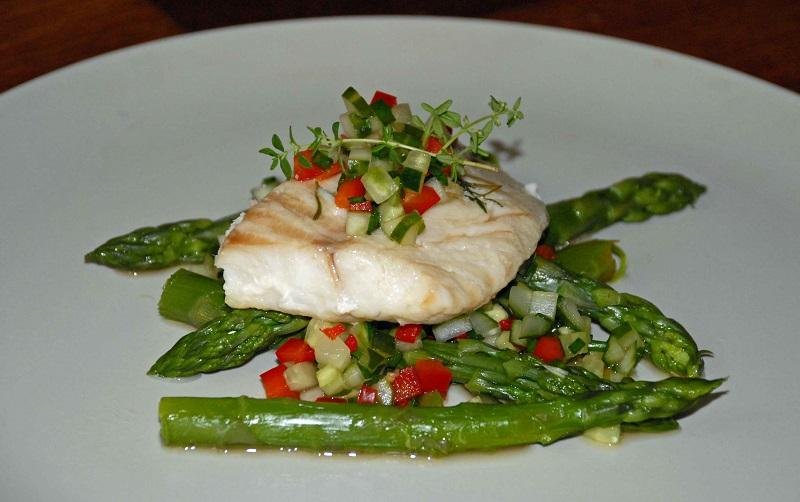
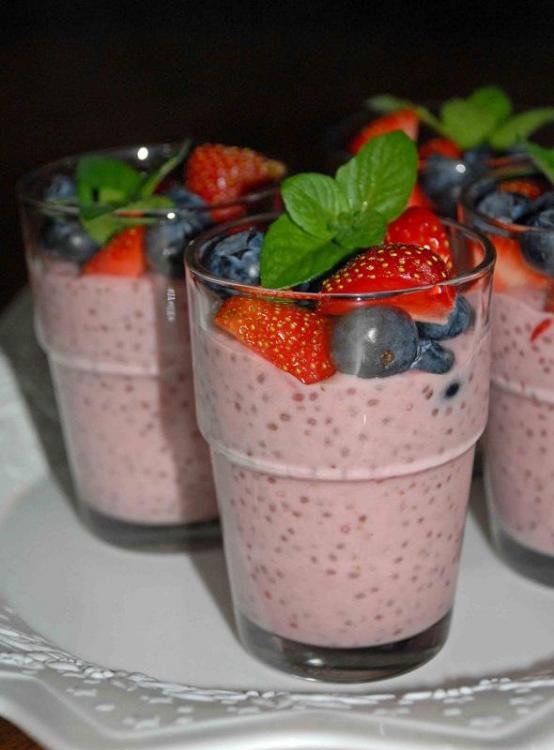
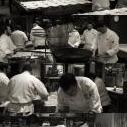

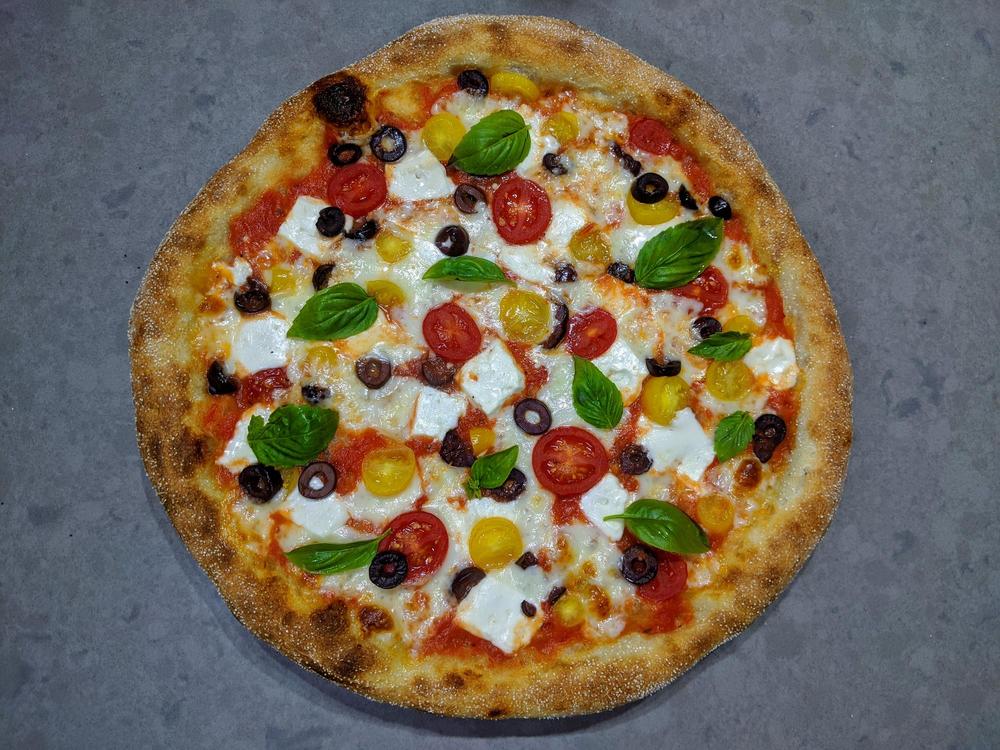

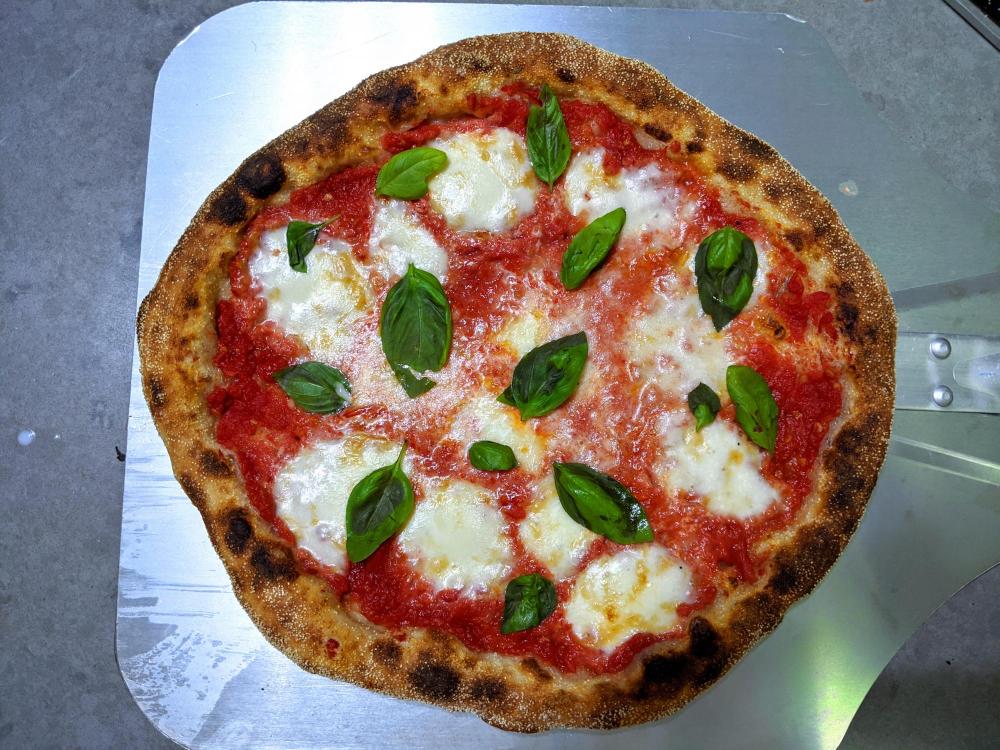
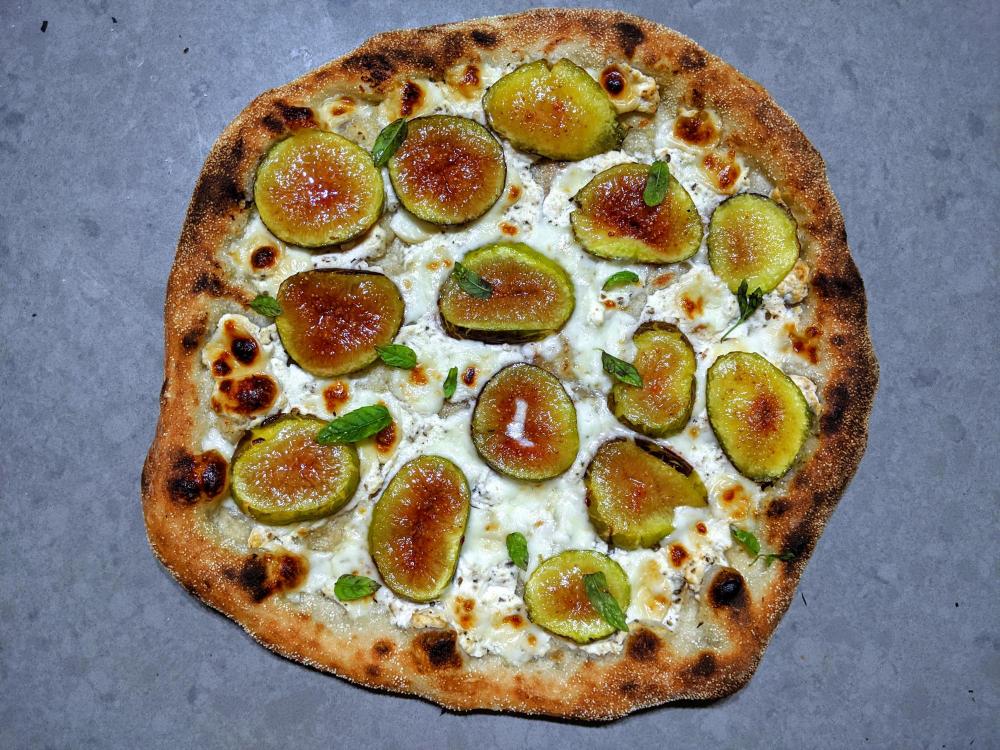
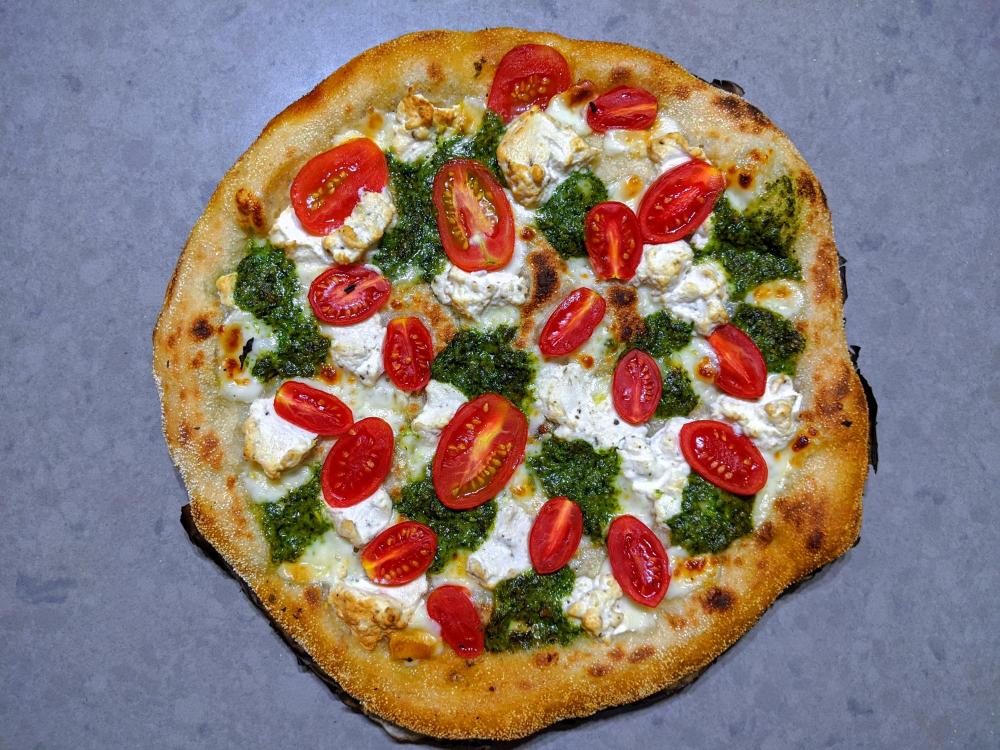
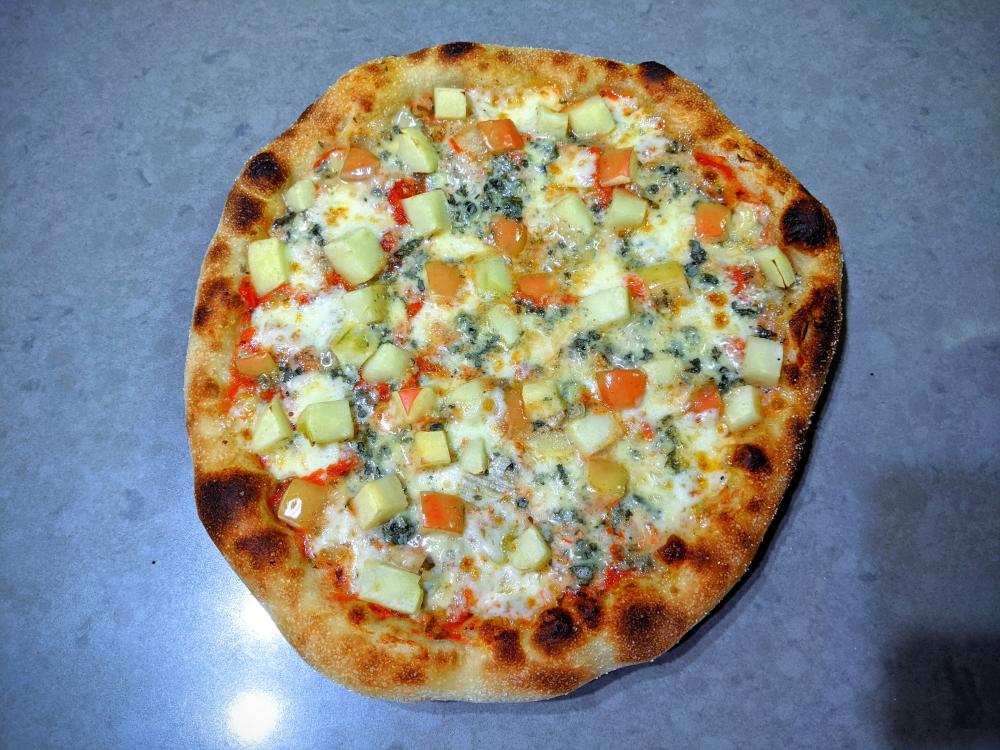
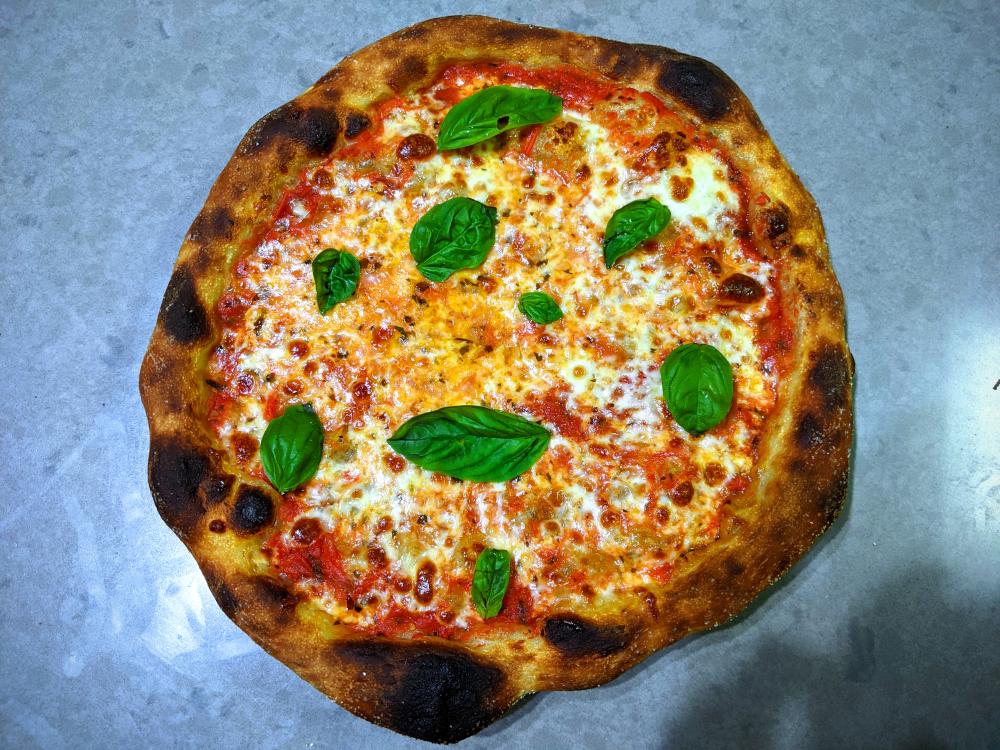

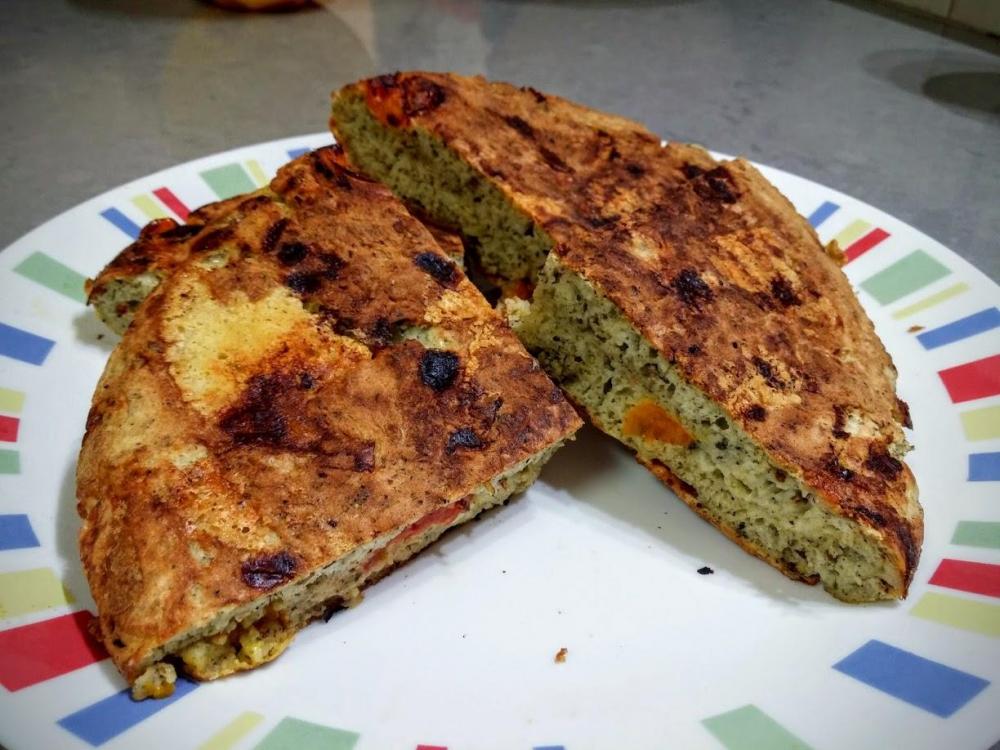



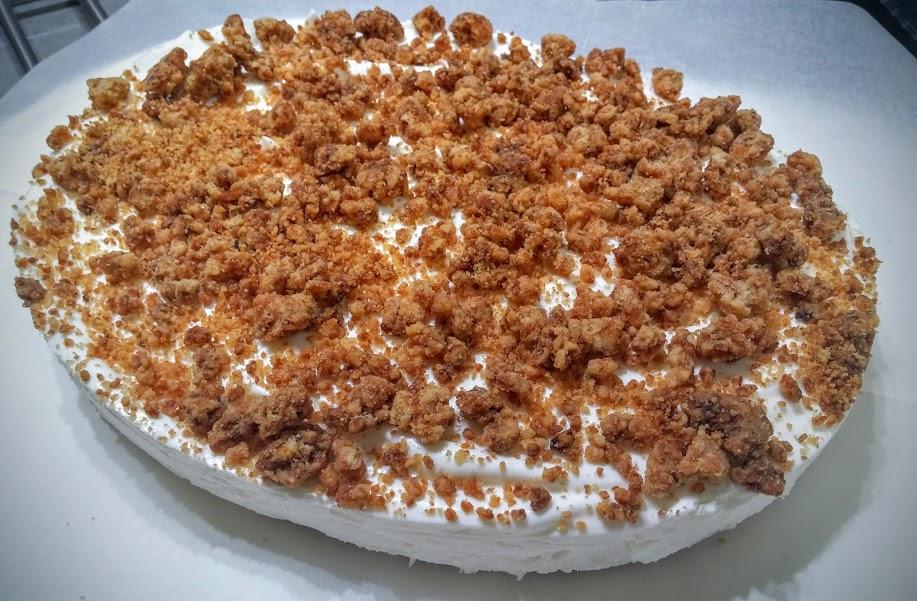
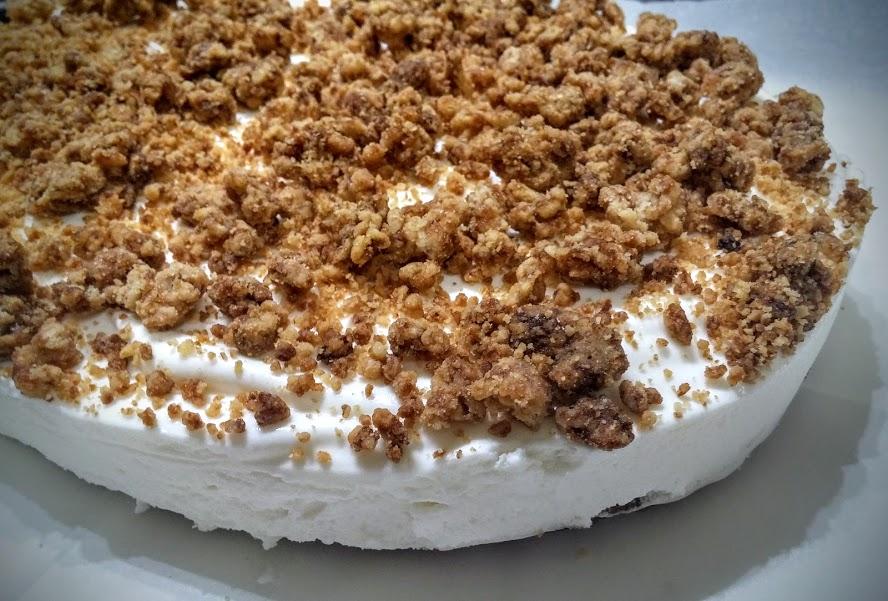

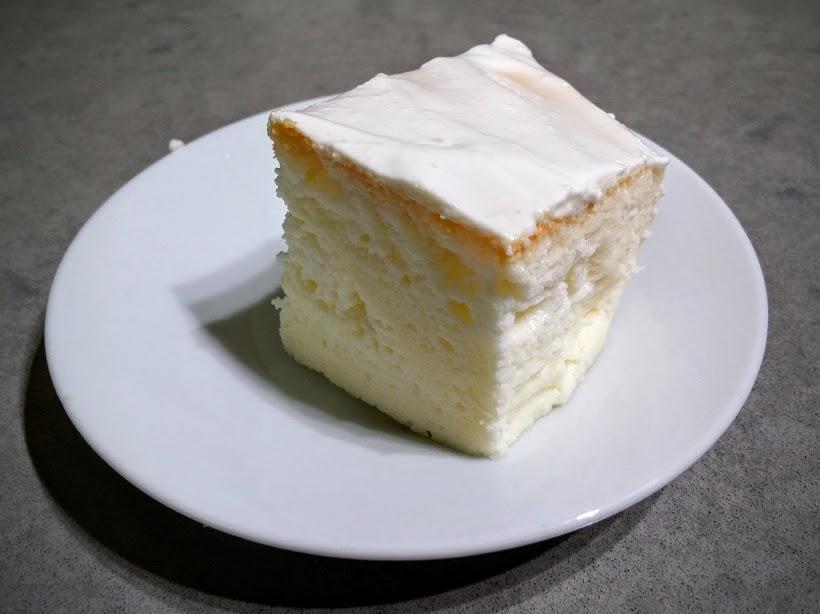
.jpg.e0f37de216fc8d99b7f69be092599fc8.jpg)

